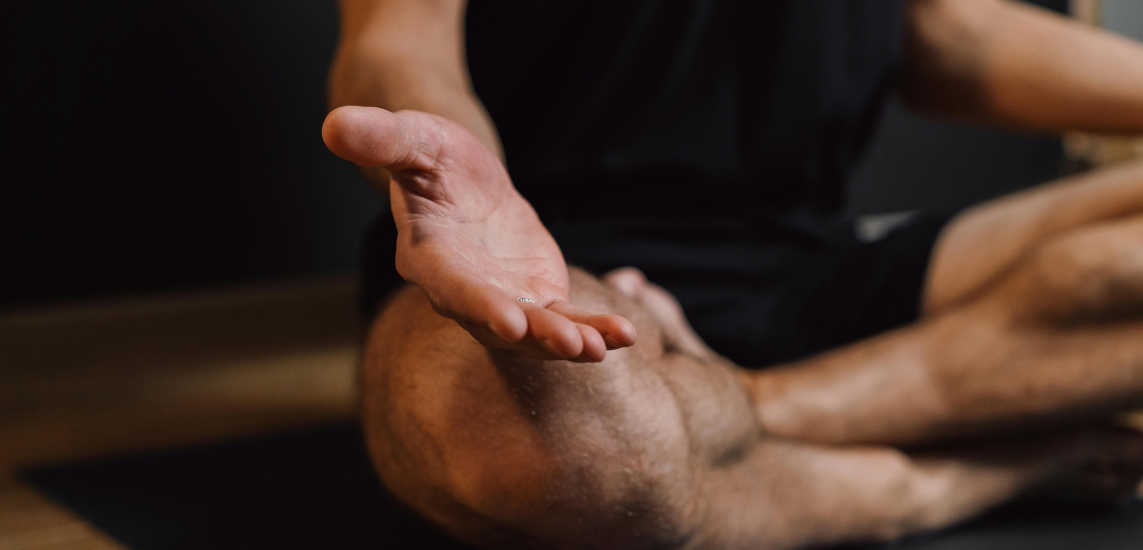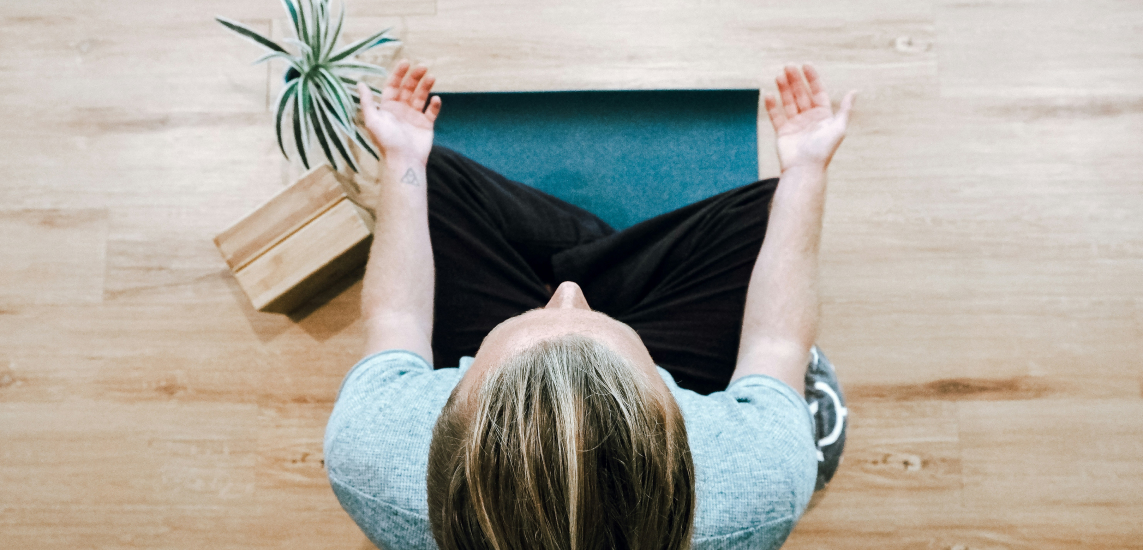On average, 1 in 3 adults live with the life-altering effects of anxiety. It affects our families, children, friends — and ourselves.
Hearts race. Palms sweat. Cheeks flush. The world spins.
When was the last time you experienced the crushing effects of anxiety?
You are not alone. Being overwhelmed with panicked emotions and thoughts like this happens to all of us. Anxiety pulls you out of the present moment and forces you to focus inward on all of your insecurities and worries about the past or future. And when you struggle with anxiety chronically, it can lead to negative physical and mental health effects.
Thankfully, you can learn to find presence in these situations by using methods like the 54321 grounding technique. The key is to cultivate mindfulness by practicing it every day. In this post, I explain this coping skill to help you manage your anxiety.
The key is to cultivate mindfulness by practicing it every day.
Key takeaways:
- Grounding is a form of mindfulness practice that is proven to reduce anxiety, stress, panic attacks, and PTSD.
- 54321 grounding is an easy coping skill to learn and do every day.
- You can help others experiencing panic and stress by teaching them grounding and other mindfulness-based techniques.
Looking for a deeper way to ground yourself? Insight Timer’s retreats platform offers immersive experiences in mindfulness, connection, and personal growth globally. Find a retreat that aligns with your goals and intentions today!
What is the 54321 grounding method?
This grounding method engages the 5 senses of your body to anchor yourself in the present moment. It is a type of mindfulness-based practice that is especially helpful in combating an anxiety spiral. The steps include focusing on:
- 5 things you can see
- 4 things you can touch
- 3 things you can hear
- 2 things you can smell
- 1 thing you can taste
The beauty of this exercise lies in how simple it is to do. It can be performed quickly and discreetly in any situation. Grounding is also flexible and easy — if you have the time, you can go slowly through each step, incorporating breathing exercises and guided meditation.
This 2024 study shows that 70% of people prefer lifestyle medicine — like meditation, yoga, exercise, and other wellness habits — over medication for the treatment of mental illness. However, they don’t feel confident in their ability to do it and turn to medication or psychotherapy first because it’s perceived as easier.
While conventional treatments like medication and formal therapy may be too costly or time-consuming, grounding and other mindfulness-based techniques are:
- easy to learn and do in daily life
- require little time commitment
- are absolutely free
How does mindfulness help with anxiety?
Practicing mindfulness allows you to be more aware of your physical and mental state, and what influences your thoughts and emotions. It brings you back to the present moment.
This is a helpful coping skill to have when mental illnesses like stress, anxiety, and depression are causing you to dwell on the past or worry about the future. Regular mindfulness practice leads to better emotion regulation, self-acceptance, and self-compassion.
Mindfulness-based stress reduction (MSBR) has been proven to be as effective as medication for the treatment of stress and many anxiety disorders, and it has fewer negative side effects compared to medication.
New to mindfulness? Get started with our premium Mindfulness Daily course to learn how to integrate more consciousness into your everyday life. Join spiritual wellness experts Jack Kornfield and Tara Brach to reduce stress, increase awareness, and improve overall well being in just less than 15 minutes a day.
The 5 senses and presence
“What if I fail and everyone judges me?”
“I’m afraid. I can’t do this.”
“I shouldn’t have done that…”
Anxious thoughts like these may feel objectively threatening but are nothing more than electrochemical flutters in the brain, skipping right over the present moment and dwelling on past regrets or future fears. When you’re steamrolled by thoughts, you disconnect from the present and get carried away, like a small boat being tossed on choppy waves. But if you can remain aware of the present, you can cultivate better emotional health.
There is only one way to reconnect to the present — through the body.
The body can only ever be in one place, and that’s the here and now.
While your mind can untether and run itself ragged on any number of anxious thoughts, your body is never anywhere else but here, with your breath. The body is in the present, and that’s why 5 senses grounding is so effective.
Connecting to your five senses is an easy way to calm anxious thoughts and reorient to the present. This is where the 54321 grounding technique can help. You can also develop long-lasting relief by practicing daily habits to relieve anxiety and stress.
How to perform the 54321 grounding method?
To calm anxiety with this coping technique, start by taking some simple deep breaths. The 5-5-5 rule is an easy breathing exercise to try:
- Inhale for 5 seconds.
- Hold for 5 seconds.
- Exhale for 5 seconds.
Repeat this process 2-3 times. If 5 seconds each feels like too much, just inhale, hold, and exhale for however long feels comfortable for you. If you have the time, Insight Timer also offers many free guided breathwork sessions and guided grounding sessions.
Here is a handy 4.6-star 5-5-5 guided meditation from Hayley Zammit to support your new skills development
Once you feel a bit calmer and centered, move on to focusing on each of your five senses. Use them to become aware of your environment.
5 things you can see
Notice the wood grain on the desk in front of you. Or the precise shape of your fingernails. Become aware of the glossy green of the plant in the corner. Take your time to look and acknowledge what you see.
It doesn’t matter what you choose to look at, so long as you’re able to focus on it for a few seconds. Try to pick up on little details. If you’re doing the grounding technique at nighttime (like in bed), you can also close your eyes and visualize 5 distinct things.
4 things you can touch
The satisfyingly rough texture of the car seat. Your cotton shirt against your neck. If you can, spend a moment literally touching these things. Maybe notice the sensation of gravity itself or the floor beneath you.
You can also become aware of different body parts. Notice how it feels to push your thumb into your palm or rub some hair between your fingers.
3 things you can hear
Distant traffic, voices in the next room, faint music playing, a dog barking. If you’re in public, it’s pretty easy to pick out 3 distinct sounds from your environment.
If you’re lying in bed at night though, this can be trickier. Try to pick out the little sounds around you — maybe the soft hum of a fan, wind blowing through the trees, crickets, your heater or AC unit running. You can also create a sound, like drumming your fingers on the end table. Try to focus on external sounds, but if you truly can’t, remember a sound in your mind. Maybe play your favorite song in your head.
2 things you can smell
If at first you don’t think you can smell anything, simply try to sense the subtle fragrance of the air around you or your own skin. You can also take a short walk to find scented things like soap, laundry, a candle, or flowers.
Be creative. Maybe you’re working at your desk and notice how your pen ink smells, or driving in your car and pick up on the scent of your leather seats. If you’re in bed, acknowledge how your blanket or your hair smells.
1 thing you can taste
The lingering suggestion of coffee on your tongue, maybe? If you’re at home, you can walk to the kitchen for a snack or brush your teeth to taste the toothpaste. And if you truly can’t taste anything or get access to food or drink at that moment, try to recall how your favorite food item tastes for a few seconds. Salty or sweet? Light or savory?
What are the benefits of the 54321 anxiety trick?
Choosing to use the five senses grounding technique has many benefits:
- It’s easy to learn and to teach to other people.
- It’s free and accessible to anyone.
- It can be done anytime, anywhere, regardless of your environment or how much time you have.
- As a mindfulness method, it’s proven to be as effective as therapy for treating anxiety.
- It leads to better emotion regulation and self-awareness when practiced regularly.
- It’s a simple and quick way to return to the present moment.
Anxiety is the most common mental health disorder worldwide and can cause chronic physical symptoms if left untreated. Mindfulness exercises like grounding help you learn healthy coping skills for difficult situations and contribute to better mental and physical health.
A calm mind is an effective mind
The 54321 grounding method is not just a trick to distract a hyperactive mind. When practiced frequently, you will notice more long-term benefits.
There’s plenty of scientific evidence to support the idea that your brain simply works better when it’s relaxed. When you’re stressed, incoming information is passed to the lower “primitive mind,” the limbic brain, where you respond reactively and unconsciously.
But when you’re calm and composed, the amygdala and hippocampus feed information through your “higher” executive brain, allowing you to think and behave with rationality. Your best option is to always cultivate tranquility and composure, so you can rationalize even if you’re facing a genuine crisis.
Of course, grounding in the present moment doesn’t magically make all your problems disappear. But with frequent practice and a balanced and present mind, you can tackle life’s challenges with centered awareness rather than anxiety.
You will find that fears and anxieties are seldom based on reality. More often they are mere stories you tell yourself — albeit very compelling ones! You’ll gradually observe that when you fully inhabit the present moment, you feel safer, calmer, and less likely to get whisked along with racing thoughts.
When to get professional help
If you are dealing with severe anxiety or PTSD, it’s important to reach out to your doctor to make sure you get any necessary clinical help. While grounding and mindfulness methods are amazing coping skills to have, they may not be enough to handle severe mental health conditions on their own.
Mindfulness-based techniques are great for immediately handling stress and anxiety and for getting out of a downward spiral. However, many situations require therapy to discuss and root out deeper issues. Make sure to seek proper care through medications and/or psychotherapy with a licensed professional if you’re struggling to heal on your own.
How do I help someone experiencing a panic attack?
It can be scary to witness someone else struggling through acute PTSD or a panic attack. You may feel helpless, like you have no idea what to do for them.
Mindfulness, breathing, and grounding exercises are a great way to guide someone through an acute crisis. Try to follow these steps:
- Guide them through deep breathing exercises (the 5-5-5 rule) to help them begin to calm and focus their mind. Perform the exercises with them and talk them through it.
- Reassure them they are safe. Ask them how you can help.
- Once they’re calmer, help them ground and pay attention to their environment. Explain what you’re doing and help them find a few things to focus on for each of their five senses.
- This meditation for panic and anxiety relief is also helpful if you can go through it with the person after they’ve calmed down.
The 54321 grounding technique: an antidote to anxiety?
Anxiety is a mental issue that keeps you dwelling on the past and worrying about the future. Using mindfulness brings you back to the present moment. This helps you to stop spiraling and leads to mental clarity. It has been proven to be as effective as medication and psychotherapy for anxiety relief.
There are many ways to develop mindfulness:
- Breathwork
- Meditation
- Yoga
- Grounding
- . . .and more
Find what works for you and practice it regularly.
The 5-4-3-2-1 grounding method is easy, free, quick, and accessible to all. It can be used during a panic attack along with deep breathing and reassurance to help someone else who is struggling. Also, make sure you reach out to your doctor if the effects of stress, anxiety, or PTSD are too much to tackle alone.
If you find that you need more help to conquer anxiety, Insight Timer has lots of free resources to cultivate mindfulness including courses and guided meditations.
Frequently asked questions
What is the sense trick for anxiety?
The sense trick is another name for the 54321 grounding exercise. It involves the same steps. Focus on:
- 5 things you can see
- 4 things you can touch
- 3 things you can hear
- 2 things you can smell
- 1 thing you can taste
What is the 3-3-3 rule?
This grounding method is similar to the 54321 technique. It asks you to”
- notice 3 things you can see
- 3 things you can hear
- move 3 different body parts
It’s another form of grounding that can help you return to the present moment.
How long should you ground every day?
There’s no set amount of time that you “should” ground each day.
54321 grounding is quick and easy by design. What’s important is to practice using it every day so that you can turn to this coping skill automatically during an anxiety spiral. Just a few minutes is enough.
What are some grounding techniques for PTSD?
Techniques that are ideal for PTSD and panic relief are especially focused on rooting you in the present. This makes you feel safe and allows your mind to calm itself. Grounding, including focusing on the five senses and doing breathing exercises, may help.
Can the 5-4-3-2-1 grounding technique be used for stress relief?
Grounding, and any type of mindfulness-based practice, is great for stress relief because it forces your mind to slow down and reconnect with your environment. This pulls you away from worrying about past or future troubles that are causing you stress.
References
Hoge, E. A., Bui, E., Mete, M., Dutton, M. A., Baker, A. W., & Simon, N. M. (2022). Mindfulness-Based Stress Reduction vs Escitalopram for the Treatment of Adults With Anxiety Disorders: A Randomized Clinical Trial. JAMA Psychiatry, 80(1). https://doi.org/10.1001/jamapsychiatry.2022.3679
Richardson, K., Petukhova, R., Hughes, S., Pitt, J., Murat Yücel, & Segrave, R. (2024). The acceptability of lifestyle medicine for the treatment of mental illness: perspectives of people with and without lived experience of mental illness. BMC Public Health, 24(1). https://doi.org/10.1186/s12889-024-17683-y
Farb, N. A. S., Anderson, A. K., & Segal, Z. V. (2012). The Mindful Brain and Emotion Regulation in Mood Disorders. Canadian Journal of Psychiatry. Revue Canadienne de Psychiatrie, 57(2), 70–77. https://www.ncbi.nlm.nih.gov/pmc/articles/PMC3303604/
Tyng, C. M., Amin, H. U., Saad, M. N. M., & Malik, A. S. (2017). The influences of emotion on learning and memory. Frontiers in Psychology, 8(1454). https://doi.org/10.3389/fpsyg.2017.01454
What is the 333 Rule for Anxiety? | MyWellbeing. (n.d.). Mywellbeing.com. https://mywellbeing.com/therapy-101/what-is-the-333-rule-for-anxiety#:~:text=It
Grounding Techniques: Exercises for Anxiety, PTSD, and More. (2019, May 24). Healthline. https://www.healthline.com/health/grounding-techniques#faq







-1.jpg)

